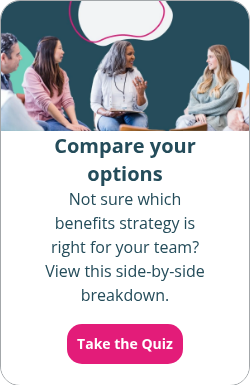Which health reimbursement arrangement is right for your client?
By Elizabeth Walker on August 2, 2024 at 10:45 AM
As a broker, you must familiarize yourself with a wide range of health benefit options before recommending one to your client. Due to the rising interest in personalized benefits, the health reimbursement arrangement (HRA) may be an increasingly popular choice for employers seeking flexible and customizable solutions for their employees.
HRAs can be very valuable for your book of business. Not only are they budget-friendly, but they save employers on taxes, give employees more freedom over their healthcare decisions, and offer greater flexibility and customization than other traditional health benefits.
But, depending on your client’s specific needs, one HRA might be a better fit than another. In this article, we’ll review everything you need to know about HRAs, including how they work, why they’re a good choice for your client, and how you can partner with PeopleKeep.
Takeaways from this blog post:
- A health reimbursement arrangement (HRA) is an IRS-approved health benefit allowing employers to reimburse their employees tax-free for qualified out-of-pocket medical expenses.
- Three popular HRAs are the qualified small employer HRA (QSEHRA), the individual coverage HRA (ICHRA), and the integrated HRA. Understanding your client's unique needs can help you determine which HRA is best for them.
- Partnering with PeopleKeep allows brokers to offer HRAs to their clients, receive compensation for referrals, and remain the agent of record for any eligible employees.
What is an HRA?
An HRA is an IRS-approved health benefit employers use to reimburse employees tax-free for over 200 qualified out-of-pocket medical expenses. Eligible expenses include prescription drugs, mental health services, emergency care, and even individual health insurance premiums.
An HRA is a flexible health benefit that can meet all your client’s needs—regardless of their company’s size, location, or budget. While HRAs are similar in some ways to other popular health benefits, they have their differences.
Here are some ways that they stand out from other options:
- Employer-owned funds: Only employers contribute to HRAs. Unused funds stay with the employer if an employee quits or retires. Tax advantages for employers: Employer contributions are tax-deductible and payroll tax-free.
- Tax-free reimbursements: Employees who have a health insurance plan that provides minimum essential coverage (MEC) receive tax-free reimbursements.
Currently, seven different types of HRAs are available. Some HRAs are stand-alone benefits, while others work with group health insurance plans. Some even only provide specific health coverage, like vision and dental. When you partner with PeopleKeep, your clients can choose from three of the most popular HRAs: the qualified small employer HRA (QSEHRA), the individual coverage HRA (ICHRA), and the integrated HRA.
These HRAs give your clients more options when deciding which competitive benefit best meets their organization's needs.
How does an HRA work?
If it’s your client’s first time learning about an HRA, they may be wary. However, how an HRA works is simple. Unlike a health savings account (HSA), your client doesn’t have to pre-fund an HRA, and they have no cash value. This means that all HRA contributions stay with your client until an employee incurs an eligible expense approved for reimbursement.
HRAs also have flexible design options. For example, your client can choose what expenses are eligible for reimbursement. Depending on the HRA, they can even set different allowance amounts based on different employee classes.
Although each HRA varies, all HRAs follow the same basic format:
- Your client sets an allowance amount. They decide how much they want to offer their employees to pay for eligible healthcare expenses. There are no minimum contribution limits or participation requirements.
- Their employees make qualified purchases. Unlike a traditional group health plan, an HRA gives employees the ability to choose the healthcare services, medical items, and individual health insurance coverage that works best for them and their families.
- Their employees submit documentation of the purchase. Before reimbursement, employees must submit proof they purchased an eligible medical expense, usually in the form of a receipt or invoice.
- Your client or their HRA administrator reviews the employee documentation. Your client reviews the documentation to check for three required items: the service or product, the date of the service or sale, and the amount the employee paid. If the documentation meets this criteria, your client approves the expense.
- Your client reimburses their employees. After approving the expenses, your client reimburses the employees up to their set allowance amount. Once they reach their allowance limit, employees can’t exceed it. However, unused funds roll over monthly.
Your client can self-administer their HRA if they choose. However, using HRA administration software like PeopleKeep is often easier and more effective. With our HRA administration software, your client will reduce the likelihood of IRS compliance complications, penalties, and HIPAA violations. Plus, we take care of the most time-consuming tasks, like documentation review and creating HRA plan documents, so they can focus their energy on managing their company.
Why an HRA is a good idea for your client
As a trusted advisor, your clients come to you for advice, and you care about their success. Being well-informed on the advantages of HRA can help you educate your clients and guide them toward the right solution for their business.
HRAs benefit your client in the following ways:
- They’re a flexible and customizable health benefit designed to suit every client’s unique needs.
- There are no annual rate hikes, rigid participation requirements, or location barriers.
- They can help your client save on their benefits budget by allowing them to set a custom allowance amount.
- Employer contributions are tax-deductible and are exempt from payroll and social security taxes.
- Because they’re not pre-funded benefits, they offer lower financial risk than other health benefits.
- They can help your client attract talented employees, improve retention, and boost their benefits package.
Which HRA is best for your client?
To determine whether an HRA is a good fit for your client’s business, you must first understand the circumstances under which a specific HRA would work best. Below, we’ll discuss a few scenarios featuring the three types of HRAs available through PeopleKeep that could benefit your client.
Qualified small employer HRA (QSEHRA)
Imagine you have a client with only five full-time employees. They don’t have the budget to offer group health insurance coverage nor the staff to manage a complex benefit. Instead, they want their eligible employees to pick the individual health policy and medical expenses that work for them without breaking the bank. If so, your client will do well with a QSEHRA.
The QSEHRA is an easy-to-use health benefit option designed for small businesses. It’s only for business owners with fewer than 50 full-time equivalent employees (FTEs) who don’t offer group health coverage, including ancillary group plan benefits. When designing the benefit, employers can choose to reimburse employees for health insurance premiums only or their monthly premiums plus qualified out-of-pocket medical costs.
Here are some other highlights about the QSEHRA:
- The IRS sets annual contribution limits for QSEHRAs. However, there are no minimum contribution limits, and allowance amounts roll over monthly. Small employers can also offer different allowance amounts to their employees based on their family status.
- If your client chooses to offer a QSEHRA, they must offer it on equal terms to all their W-2 full-time employees. They can also add part-time employees to the benefit as long as they receive the same allowance as full-time employees.
- Employees who want to participate in the benefit must have a medical plan that provides MEC.
- Employees on their spouses' group health plan can receive reimbursements for their joint insurance premiums.
Lastly, if your client has employees who receive premium tax credits, they can still take advantage of the QSEHRA. However, they must coordinate their credits with the HRA based on affordability.
Individual coverage HRA (ICHRA)
Say you have a client who runs a remote company with 30 full-time employees. They currently offer group health insurance to employees in one state but want to provide a few employees in another state a different health benefit—one where they can pick their own coverage. They have a flexible budget for this benefit but want more control over plan eligibility and design. If this sounds like your client, they will benefit from an ICHRA.
The following are key features of the ICHRA:
- The ICHRA is for employers of all sizes, has no contribution limits, and can coordinate with premium tax credits based on affordability.
- Employees must have a qualifying form of individual health coverage to participate in the ICHRA. Therefore, employees on a family member's group policy or with an alternative health benefit, like a healthcare sharing ministry, can’t participate.
- The ICHRA allows employers to tailor their benefit through job-based employee classes, like full-time or part-time status. Your client can use employee classes, to structure benefit eligibility, set custom allowance amounts, and customize the benefit more effectively.
- It’s also important to note that your client can’t offer employees within the same class the choice between group health insurance and the ICHRA—they can only offer employees in each class one or the other.
Lastly, applicable large employers (ALEs) can leverage the ICHRA as an alternative to traditional group health plans to satisfy the Affordable Care Act’s employer mandate.
Integrated HRA
Now imagine you have a client who runs a nonprofit organization and has been offering its 17 employees group health insurance for the past several years. However, rising healthcare prices have become too unaffordable for them. Your client wants to continue offering group health insurance at a more reasonable price while still providing its employees with a strong health benefit to retain talent. In this case, an integrated HRA would be the right fit.
The integrated HRA, also known as the group coverage HRA (GCHRA), is for organizations of all sizes looking to supplement their employer-sponsored group health plan. Only employees enrolled in your client’s traditional group health plan can participate in the integrated HRA. Employees with an individual health plan are ineligible.
Below are more details about the integrated HRA:
- With an integrated HRA, your client’s monthly allowance can go towards their employees’ eligible expenses—such as deductibles, coinsurance, and other medical items listed in IRS Publication 502—that their group health plan doesn't fully cover1.
- While any group health plan can work with an integrated HRA, your client can save money on their premiums by switching to a high-deductible health plan. Their employees can offset the plan’s higher deductible to pay for out-of-pocket medical expenses.
- Group plan premiums are ineligible expenses for reimbursement.
- Like the ICHRA, the integrated HRA has no maximum allowance caps, and your client can offer different allowance amounts to different employees based on specific classes of employees for extra personalization.
How to refer your clients to PeopleKeep
At PeopleKeep, we strive to make personalized benefits more accessible to help businesses of all sizes better care for their employees. But, we also strive to support our broker partners, too.
By partnering with PeopleKeep, you can offer more health benefit options that other advisors don’t know about or understand. We’ll help you learn everything you need to know about HRAs so you can make the best recommendation possible for your clients.
We also allow you to remain the agent of record for any client you set up with PeopleKeep so you can support your clients’ employees while they enroll in health and ancillary plans.
The PeopleKeep Partner Compensation Program is our way of thanking you for partnering with us and suggesting a customized HRA to your clients. When you refer a client who signs up with us, we’ll waive their $150 sign-up fee, and pay you a referral bonus.
You can choose the compensation structure for your bonus that works best for you, such as a recurring annuity or a one-time payout. Additionally, partners who refer multiple organizations that result in three or more sign-ups per calendar year qualify for extra compensation.
Whether the QSEHRA, ICHRA, or GCHRA meets your client’s needs, a referral from their trusted advisor is the best way to get them started.
Conclusion
With an HRA, your clients can control their budget and save on taxes while providing their employees with a comprehensive health benefit. But before you get started, it’s essential to understand the scenarios where each HRA works best so you can make knowledgeable recommendations and better support your client’s overall needs.
With PeopleKeep, we can help your client reach their goal of offering a personalized health benefit at their company. We'll be your HRA education partner so you can help your clients provide their employees with the best benefits possible. And even better, we’re happy to pay you a referral bonus to thank you for bringing them to us.
This article was originally published on August 22, 2022. It was last updated on August 2, 2024.
Check out more resources
See these related articles

HRAs and W-2 annual reporting
Learn about HRA W-2 annual reporting requirements. Understand what employers need to include on employees' W-2 forms for HRA compliance.

What can an HRA reimburse?
Wondering if your HRA can cover specific medical costs? Discover the comprehensive list of eligible expenses that your HRA can reimburse in this article.

Can I have an HRA and an FSA at the same time?
Learn if you can have an HRA and an FSA at the same time. Understand the rules, benefits, and how these accounts can work together for healthcare costs.



